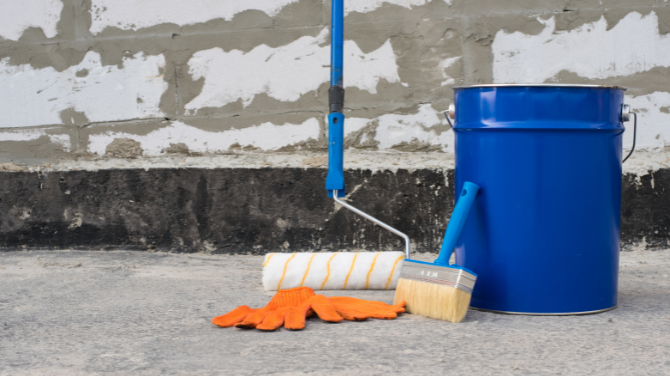What Are The Advantage Of Waterproofing Concrete
Waterproofing is the most important part to be focused on while constructing a home. From the roof to the basement, the home’s interior spaces must be maintained dry and waterproof. Damages from water penetration might include insect infestation, fungal growth, and, in the worst situations, structure failure. These issues can be avoided by waterproofing the home before construction. Your home will be protected from future damage if you waterproof the concrete and make it stronger to face any leakage, seeping, and dampness. In this article, you’ll go through some of the crucial topics like types of concrete waterproofing, key benefits of waterproofing concrete, and types of waterproofing concrete without wasting any time. Let’s get started.
Types of Concrete Waterproofing
Cementitious Waterproofing
The simplest type of waterproofing used in construction is cementitious. Concrete can be waterproofed using products that are readily available in the marketplace. This technique is applied in moist places like bathrooms and restrooms. However, because it is utilized in interior wet spaces like bathrooms and toilets, it is guarded against sunlight and degradation. As a result, there won’t be any expansion or contraction of cementitious waterproofing.
Liquid Waterproofing
Membrane A liquid membrane is a thin coating that is typically applied by spraying or rolling on two layers of liquid waterproof after a primer coat. It provides greater flexibility than cementitious waterproofing because it forms a rubbery layer on the area where it is applied. The kind of polymer that is utilized to create liquid waterproofing affects how long it will last. Asphalt that has been polymer-modified makes up a liquid membrane. Membranes made of polyurethane liquid are also utilized for waterproofing.
Bituminous Coating
Asphalt coating, also known as bituminous coating, is flexible and protective. It is an excellent waterproofing and protective coating, especially for concrete foundation surfaces. Bituminous coating is not meant to be exposed to sunlight because it is made of a bitumen-based substance. Continuous exposure to sunlight causes it to become highly brittle and fragile.
Bituminous Membrane
Low-sloped roof waterproofing is widely performed using bituminous membranes. Self-adhesive and a torch are features of the bituminous membrane. A self-adhesive compound is made up of filler, polymers, and asphalt. Because the membrane’s bonding properties weaken with time, the self-adhesive type has a limited shelf life. A mixture of organic liquids that are extremely sticky, viscous, and waterproof make up this material. The bituminous coating on the member is melted for bonding using a torch-on membrane.
Admixtures
Over the past few years, a brand-new kind of waterproofing has been popular everywhere. These additives are mixed into the concrete at the batching plant or on the job site, where they cause a chemical reaction that turns the concrete into a water barrier. Integral concrete waterproofing methods can use densifiers, water repellents, or crystalline admixtures.
Crystalline Admixtures
Typical forms of crystalline-based systems are dry powders. Crystalline systems really utilize the water that is already present in the concrete to build crystals inside it, effectively blocking the paths for moisture that could otherwise harm the concrete’s water barrier. Common Steps Involved in WaterProofing
Surface Preparation
Remove all loose debris, dust, and oil from the surface by thoroughly cleaning it. All membrane-based waterproofing coating technologies place a significant emphasis on surface cleaning.
Application of Primary
Coat To prepare the structure’s surface, apply a primary coat on it. Bitumen membranes can be primed with water-based or solvent-based primers.
Unrolling the Membrane Sheets
The sheets are rolled out on the surface of the structure after being checked for proper alignment and adjusted as necessary.
Heating the Membranes
The layer that has been burned off from the membrane’s underside face should be heated using a torch. The membrane is now prepared for bonding with the underside of the concrete surface.
Pressing the Membrane
Make sure the membrane properly adheres to the concrete surface by applying firm pressure. For proper bonding, extra attention must be paid to overlaps, edges, and angles. Key Benefits of Concrete waterproofing is an essential component of any construction, especially with high-rise structures. In fact, according to experts, a structure’s stability depends in part on how well waterproofing is applied. If not done correctly, the structure is prone to water damage, endangering both the surrounding property and the people within as well as their health and safety.
Following are some of the key benefits of waterproofing concrete:
It strengthens the building
By reducing the number of entry points for water and moisture through the floor, walls, and ceiling, various waterproofing chemicals can increase the lifespan of a structure. Rust, rotting, corrosion, and other forms of destruction can be avoided if these locations are adequately protected from waterproofing solutions.
Stops the beginning of health issues
Mold and mildew develop when water or moisture manages to get inside a building’s walls and ceilings. As a result, spores are produced, which may cause a number of health issues. When you breathe in, spores are released into the air and immediately make their way to your lungs.
It lowers the expense of maintenance
A practical way to avoid costly repairs is to waterproof concrete. You might anticipate having fewer maintenance issues with a structure that hasn’t suffered from water damage. Electrical work, painted surfaces, and material items can all be affected by water damage. The smallest quantity of water seeping into a structure can easily lead to larger tragedies since it can cause concrete to build up or crack.
It raises a building’s valuation
Nobody wants a house with waterproofing issues. The correct cementitious waterproofing method can stop water seepage from causing structural damage. It raises your property’s worth preserving the building’s visual attractiveness.
Enhances property’s overall look
The majority of the time, concrete that has been waterproofed looks much nicer than concrete that has been exposed to the elements for a long period. A beautifully maintained and waterproofed property can be one of the attractions of your house or other property.
Wrapping up the article, concrete waterproofing is an essential part of every construction. It is a useful technique for the longer-term reduction of a structure’s permeability, shrinkage, and chemical resistance. All of the benefits and types related to waterproofing concrete are helpful when building a solid construction for a longer period
Redwop is a prime waterproofing manufacturer in India that is involved in the production of a wide array of waterproofing solutions used in numerous residential and commercial construction applications. These solutions are manufactured using state-of-the-art technology and comply with international standards of construction.

